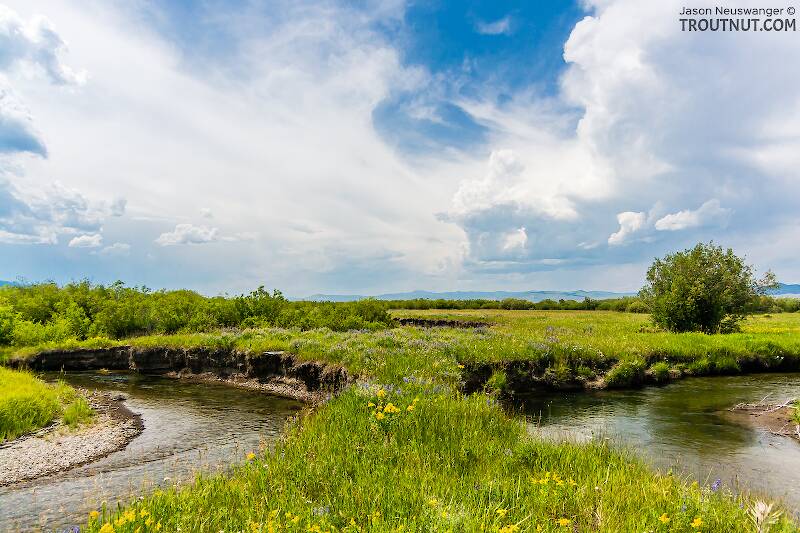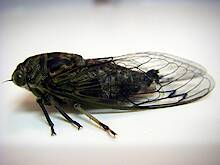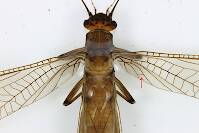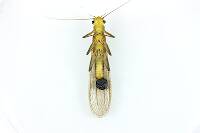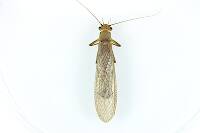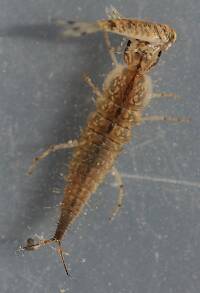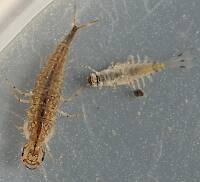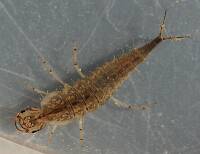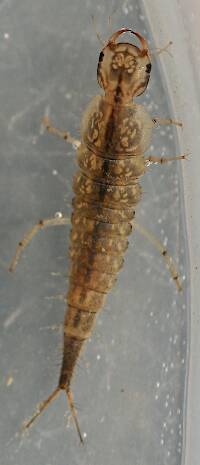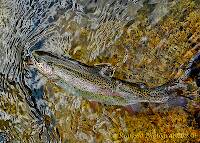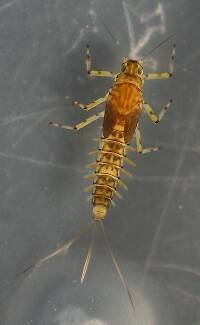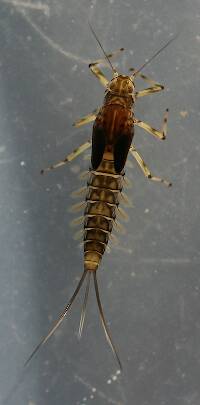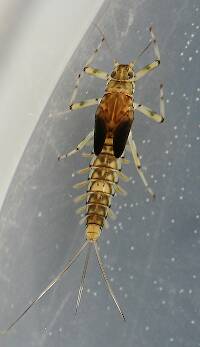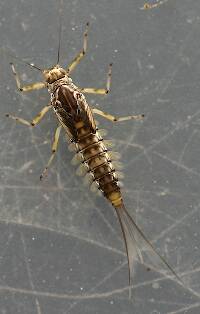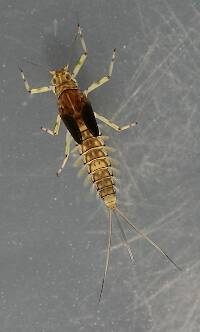
Hex Mayflies
Hexagenia limbata
The famous nocturnal Hex hatch of the Midwest (and a few other lucky locations) stirs to the surface mythically large brown trout that only touch streamers for the rest of the year.
Featured on the forum

This is the first of it's family I've seen, collected from a tiny, fishless stream in the Cascades. The three species of this genus all live in the Northwest and are predators that primarily eat stonefly nymphs Merritt R.W., Cummins, K.W., and Berg, M.B. (2019).

Troutnut is a project started in 2003 by salmonid ecologist Jason "Troutnut" Neuswanger to help anglers and
fly tyers unabashedly embrace the entomological side of the sport. Learn more about Troutnut or
support the project for an enhanced experience here.
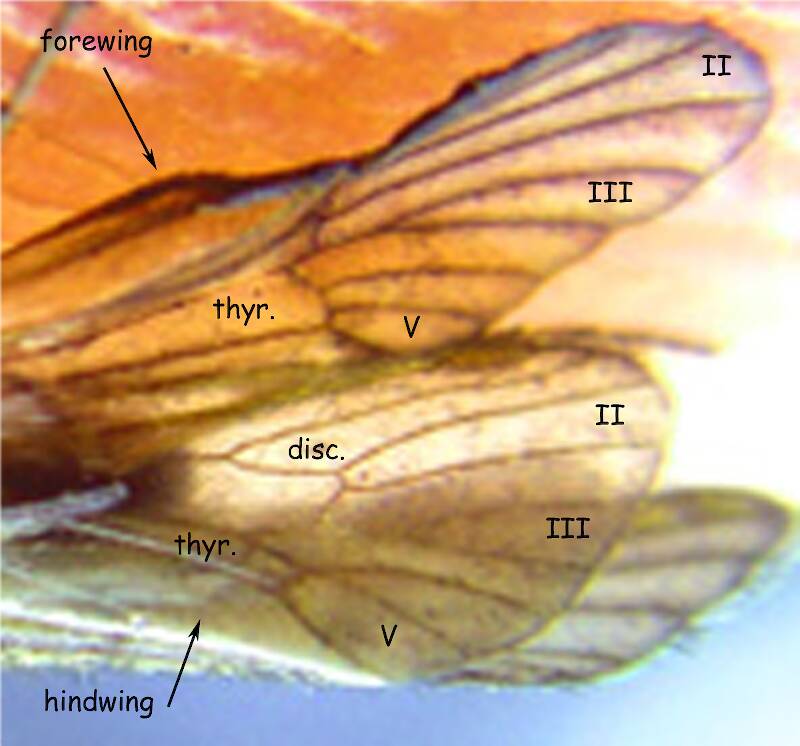
Creno on May 12, 2008May 12th, 2008, 7:07 am EDT
Folks: I have attached a revised portion of the caddis photo Daytripper provided. The wings are actually in pretty good position for figuring out what the critter is. The really nice adult caddis photos which are typical of this site usually show a critter sitting perfectly naturally on a thumb/stick/rock. However such photos almost never provide a view of the hindwing and even the forewing venation is usually folded and blurred by the hairs.
The hindwing of Daytripper's photo shows this is not a brachycentrid as brachycentrid hindwing venation usually is missing veins and cells. The combination of location, general body shape and color, the wing shape, open hindwing discoidal cell and closed hindwing thyridial cell pretty much leave us only with Apatania. One character that would be most useful would be slightly better resolution of head. Presence of ocelli would leave out the brachycentrids as well but the photo doesn't quite have the resolution necessary to be sure if ocelli are present.
I am not aware of an Apatania "key" either although I believe only A.incerta and A. nigra occur in eastern NA and both are liklely to occur in the Adirondacks although A.nigra is rare that far south. In any case it would likely require examination of the hind parts which are fairly different between the two species. I believe I have A.nigra adults so I could prepare wings to see if there is any difference between the two if you want.
The hindwing of Daytripper's photo shows this is not a brachycentrid as brachycentrid hindwing venation usually is missing veins and cells. The combination of location, general body shape and color, the wing shape, open hindwing discoidal cell and closed hindwing thyridial cell pretty much leave us only with Apatania. One character that would be most useful would be slightly better resolution of head. Presence of ocelli would leave out the brachycentrids as well but the photo doesn't quite have the resolution necessary to be sure if ocelli are present.
I am not aware of an Apatania "key" either although I believe only A.incerta and A. nigra occur in eastern NA and both are liklely to occur in the Adirondacks although A.nigra is rare that far south. In any case it would likely require examination of the hind parts which are fairly different between the two species. I believe I have A.nigra adults so I could prepare wings to see if there is any difference between the two if you want.
GONZO on May 12, 2008May 12th, 2008, 7:35 am EDT
Thanks very much for the annotated enlargement, Dave. I hereby rescind my brachycentrid speculation and congratulate Roger for a nice call. Now, about that mayfly....
DayTripper on May 12, 2008May 12th, 2008, 8:14 am EDT
Creno & Gonzo,
I've got the bigger versions of the pics I provided, plus a couple other shots I took on file. If you're interested in seeing them, let me know and I'll dig them up.
I've got the bigger versions of the pics I provided, plus a couple other shots I took on file. If you're interested in seeing them, let me know and I'll dig them up.
GONZO on May 12, 2008May 12th, 2008, 8:43 am EDT
Yes, please. The caddisfly ID seems pretty well resolved, but I'd be curious to see what else might be revealed in other photos of the mayfly.
DayTripper on May 12, 2008May 12th, 2008, 9:27 am EDT
I had several angles on the caddis fly, only the one on the BWO, however one of the pother pics from the same angle is shows a little better detail.
If you go to the page below, you'll see the original pic, plus one underneath. Just click the pics to enlarge them, then you can click the pic again to zoom in
http://daytripperblog.com/fish-food/looking-for-latin/
If you go to the page below, you'll see the original pic, plus one underneath. Just click the pics to enlarge them, then you can click the pic again to zoom in
http://daytripperblog.com/fish-food/looking-for-latin/
GONZO on May 12, 2008May 12th, 2008, 10:03 am EDT
Thanks, Alex. The enlargement on your site did seem to solve one puzzle--the hindwing on the near side appears to be torn off.
DayTripper on May 12, 2008May 12th, 2008, 10:35 am EDT
Yeah I noticed that too. Funny thing is, I didn't tear it off. I wonder what happened to it?
GONZO on May 12, 2008May 12th, 2008, 10:53 am EDT
Stuff happens. It might have been an emergence problem.
Quick Reply
Related Discussions
Topic
Replies
Last Reply
9
Jun 17, 2015
by Oldredbarn
by Oldredbarn
0
May 6, 2011
by Jtberez
by Jtberez

